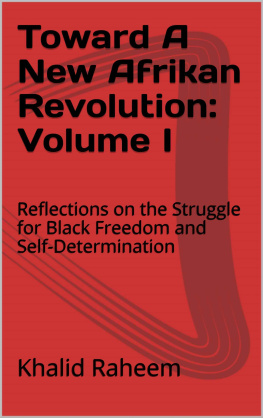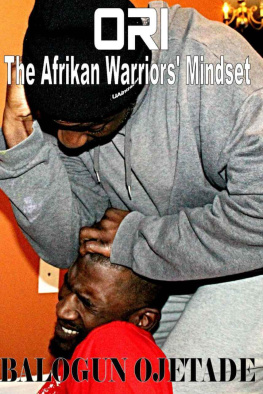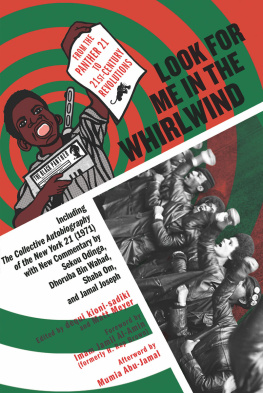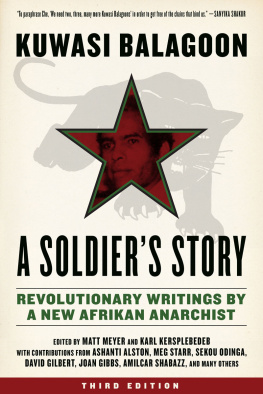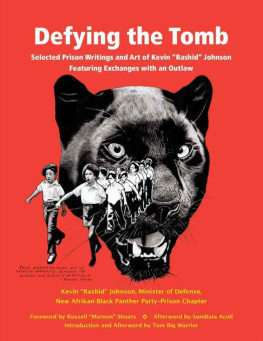Sundiata Acoli - An Updated History Of The New Afrikan Prison Struggle
Here you can read online Sundiata Acoli - An Updated History Of The New Afrikan Prison Struggle full text of the book (entire story) in english for free. Download pdf and epub, get meaning, cover and reviews about this ebook. year: 1998, genre: History. Description of the work, (preface) as well as reviews are available. Best literature library LitArk.com created for fans of good reading and offers a wide selection of genres:
Romance novel
Science fiction
Adventure
Detective
Science
History
Home and family
Prose
Art
Politics
Computer
Non-fiction
Religion
Business
Children
Humor
Choose a favorite category and find really read worthwhile books. Enjoy immersion in the world of imagination, feel the emotions of the characters or learn something new for yourself, make an fascinating discovery.

- Book:An Updated History Of The New Afrikan Prison Struggle
- Author:
- Genre:
- Year:1998
- Rating:5 / 5
- Favourites:Add to favourites
- Your mark:
- 100
- 1
- 2
- 3
- 4
- 5
An Updated History Of The New Afrikan Prison Struggle: summary, description and annotation
We offer to read an annotation, description, summary or preface (depends on what the author of the book "An Updated History Of The New Afrikan Prison Struggle" wrote himself). If you haven't found the necessary information about the book — write in the comments, we will try to find it.
An Updated History Of The New Afrikan Prison Struggle — read online for free the complete book (whole text) full work
Below is the text of the book, divided by pages. System saving the place of the last page read, allows you to conveniently read the book "An Updated History Of The New Afrikan Prison Struggle" online for free, without having to search again every time where you left off. Put a bookmark, and you can go to the page where you finished reading at any time.
Font size:
Interval:
Bookmark:
By Sundiata Acoli
December 1998
For more information about Sundiata Acoli and how to support him visit SundiataAcoli.Org
This ePub was made by Ian Schlom 13 September 2020 with text retrieved from the aforementioned website.
You can read Acoli's profile on the Jericho Movement website here.
Free Sundiata Acoli Now!
Black Lives Matter!
Free All Political Prisoners!
This article was first written at the request of the New Afrikan Peoples Organization (NAPO). Its original title was The Rise and Development of the New Afrikan Liberation Struggle Behind The Walls. It was first published as A Brief History of the New Afrikan Prison Struggle and then updated several years later to its present form.
Although this work focuses almost exclusively on New Afrikan prisoners and their struggle, it is by no means intended to discount the many long heroic prison struggle and sacrifices by all other nationalities the Puerto Ricans Native Americans, Mexicans, Whites, Asians and others. Raphael Cancel Miranda, who led the work stoppage of the USP Marion (United States Penitentiary in Marlon, Illinois) in 1972 in response to the beating of a Mexican prisoner, has been one of my heroes and role models since I first became aware of him, long ago. The same can be said of Lolita Lebron whom Assata Shakur did time with the Alderson Womens Penitentiary and of numerous other prisoners of all different nationalities whom Ive done time with and struggled together with during the long years of my imprisonment.
There are so many deserving prisoners of all nationalities that it would extend this article indefinitely to include them all and I did not feel justified in including some if I couldnt include all. Nor did I feel presumptuous enough to write a prison history of other nationalities who are best suited to record their own history. My main intent is to chronicle the history of the New Afrikan prison struggle which for too long has been written by others who often took it upon themselves to read out of history those Black prisoners and Black prison organizations who did not fit their molds as fit to print about in the history of Black prison struggle.
The New Afrikan liberation struggle behind the walls refers to the struggle of Black prisoners, behind the walls of U.S. penal institutions, to gain liberation for ourselves, our people, and all oppressed people. We of the New Afrikan Independence Movement spell Afrikan with a k as an indicator of or cultural identification with the Afrikan continent and because Afrikan linguists originally used k to indicate the c sound in the English language. We use the term New Afrikan instead of Black, to define ourselves as an Afrikan people who have been forcibly transplanted to a new land and formed into a new Afrikan nation in North America. But our struggle behind the walls did not begin in America.
The Afrikan prison struggle began on the shores of Afrika behind the walls of medieval pens that held captives for ships bound west into slavery. It continues today behind the walls of modern U.S. penitentiaries where all prisoners are held as legal slaves a blatant violation of international law, as is the present U.S. policy of executing minors and the mentally impaired.
The conception of prison ideology began to take form as far back as the reign of Louis XIV of France (1643-1715) when the Benedictine monk Mabillon wrote that: . Penitents might be secluded in cells like those of Carthusian monks and there being employed in various sorts of labor. In 1790, on April 5th, the Pennsylvania Quakers actualized this concept as the capstone of their 14-year struggle to reform Philadelphias Walnut Street Jail. No longer would corporal punishment be administered. Henceforth, prisoners would be locked away in their cells with a Bible and forced to do penitence in order to rehabilitate themselves. Thus was born the penitentiary.
The first prison physically designed to achieve total isolation of each prisoner was the Eastern State Penitentiary, better known as Cherry Hill, in Philadelphia, constructed in 1829 with cells laid out so that no prisoner ever saw another person but his guards. This separate system represented by Cherry Hill was being rivaled by an alternative, the silent system, which was designed specifically for exploiting mass convict labor. Under the latter system, prisoners were housed in solitary cells but worked together all day as an ideal source of cheap reliable labor, under rigorous enforcement of the rule that all convicts must maintain total silence. The model for this system was set up at Auburn, New York, in 1825, where they initiated the lock step so that guards could maintain strict control as the prisoners marched back and forth between their cells and their industrial workshops.
By 1850, approximately 6,700 people were found in the nations newly emerging prison system. Almost none of the prisoners were Black. They were more valuable economically outside the prison system because there were other means of racial control. During this time most New Afrikan (Black) men, women, and children were already imprisoned for life on plantations as chattel slaves. Accordingly, the Afrikan struggle behind the walls was carried on primarily behind the walls of slave quarters through conspiracies, revolts, insurrections, arson, sabotage, work slowdowns, poisoning of the slave master, self maiming, and runaways. If slaves were recaptured, they continued the struggle behind the walls of the local jails, many of which were first built to hold captured runaways. Later they were also used for local citizens.
Even before the end of the Civil War, a new system had been emerging to take the place of the older form of slavery the convict lease system. Thus, shortly after 1850, the imprisonment rate increased, then remained fairly stable with a rate of between 75 and 125 prisoners per 100,000 population. The Afrikan struggle continued primarily behind the slave quarters walls down through the issuance of the Emancipation Proclamation. This was a declaration issued by President Lincoln on January 1, 1863, during the height of the Civil War. It declared the slaves free only in those states still in rebellion and had little actual liberating effect on the slaves in question. Their slave masters, still engaged in war against the Union, simply ignored the declaration and continued to hold their slaves in bondage. Some slave masters kept the declaration secret after the war ended following Lees surrender on April 9, 1865. As a result, news of the Emancipation Proclamation did not reach slaves in Texas until June 19, 1865. This date, called Juneteenth is celebrated annually by New Afrikans in Texas and outlying states as Black Independence Day.
Immediately after the Civil War and at the end of slavery, vast numbers of Black males were imprisoned for everything from not signing slave like labor contracts with plantation owners to looking the wrong way at some White person or for some similar petty crime. Any transgression perceived by Whites to be of a more serious nature was normally dealt with on the spot with a gun or rope provided the Black was outnumbered and out armed. Black-on-Black crime was then, as now, considered to be petty crime by the U.S. justice system. But petty or not, upon arrest most New Afrikans were given long, harsh sentences at hard labor.
Within five years after the end of the Civil War, the Black percentages of the prison population went from close to zero to 33 percent. Many of these prisoners were hired out to Whites at less than slave wages. This new convict lease system appeared to have great advantages for the landowners: they did not own the convicts, and hence could afford to work them to death. (The movie Gone With The Wind actually uses this new form to glorify the older system by comparison.) The President of the Board of Dawson, discovered that in 1869 the death rate among leased Alabama Black convicts was 41 percent. Some restraints were obviously necessary; Mississippi managed to reduce its annual death rate for leased Black convicts between 1882 and 1887 to a more 15 percent. Overnight prisons had become the new slave quarters for many New Afrikans. Likewise, the Afrikan prison struggle changed from a struggle behind the walls of slave quarters to a struggle behind the walls of county workhouses, chain gain camps, and the plantations and factories that used leased convicts as slave laborers.
Font size:
Interval:
Bookmark:
Similar books «An Updated History Of The New Afrikan Prison Struggle»
Look at similar books to An Updated History Of The New Afrikan Prison Struggle. We have selected literature similar in name and meaning in the hope of providing readers with more options to find new, interesting, not yet read works.
Discussion, reviews of the book An Updated History Of The New Afrikan Prison Struggle and just readers' own opinions. Leave your comments, write what you think about the work, its meaning or the main characters. Specify what exactly you liked and what you didn't like, and why you think so.

